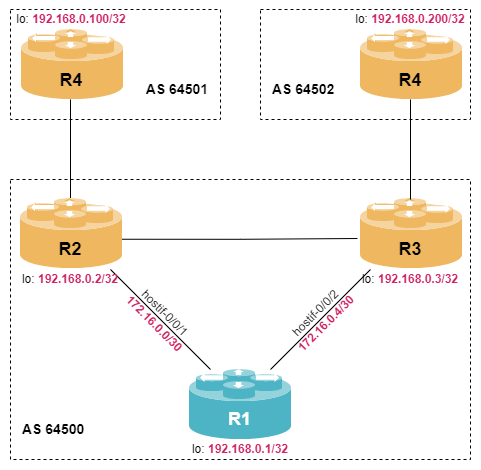BGP Route Reflectors
Module Introduction
Before you start the hands-on part of this module, you should load the appropriate configuration and verify that the testbed is up and running by executing the corresponding robot file:
student@tour:~/trainings_resources/robot$ robot bgp_rr/bgp_rr_setup.robotBGP Route Reflection
We have learned in the last module that BGP peers do not advertise prefixes learned from one internal neighbor to another internal neighbor in order to avoid loops.
As a consequence, all internal BGP peers need to peer with all other internal BGP peers resulting in a full-mesh of BGP peerings. With n routers within an autonomous system, this results in n*(n-1)/2 BGP sessions which need to be maintained.
A special internal BGP peer called a route reflector was defined in RFC 4456 which allows to re-advertised iBGP learned routes to certain iBGP peers called route reflector clients in the following way:
-
A route learned from a non-client iBGP peer is advertised (reflected) to all client peers.
-
A route learned from a client iBGP peer is advertised (reflected) to all non-client and client peers.
Two new BGP attributes are introduced to avoid routing loops: the originator-id and the cluster-list. Each route reflector is assigned a cluster-id which is prepended to the cluster-list. If a route reflector learns a route that already has his own cluster-id in the cluster-list, it detects the loop.
The route reflector properties are configured within the peer-group on a per address-family basis.
| The route reflector client is not aware of the fact that is part of a route reflector cluster, i.e., configuration is only done on the route reflector. |
We use the following setup:

Configure R1 to be a route reflector with clients R2 (192.168.0.2) and R3 (192.168.0.3). The cluster-id should be set to 1.1.1.1.
Click to reveal the answer
cfg> set instance default protocol bgp hostname R1
cfg> set instance default protocol bgp local-as 64500
cfg> set instance default protocol bgp router-id 192.168.0.1
cfg> set instance default protocol bgp address-family ipv4 unicast
cfg> set instance default protocol bgp peer ipv4 192.168.0.2 192.168.0.1
cfg> set instance default protocol bgp peer ipv4 192.168.0.2 192.168.0.1 peer-group INTERNAL
cfg> set instance default protocol bgp peer ipv4 192.168.0.3 192.168.0.1
cfg> set instance default protocol bgp peer ipv4 192.168.0.3 192.168.0.1 peer-group INTERNAL
cfg> set instance default protocol bgp peer-group INTERNAL
cfg> set instance default protocol bgp peer-group INTERNAL remote-as 64500
cfg> set instance default protocol bgp peer-group INTERNAL address-family ipv4 unicast
cfg> set instance default protocol bgp peer-group INTERNAL address-family ipv4 unicast route-reflect-client true
cfg> set instance default protocol bgp cluster-id 1.1.1.1
cfg> show bgp rib-in ipv4 unicast peer R2
Instance: default, AFI: ipv4, SAFI: unicast
Hostname: R2, Peer IP: 192.168.0.2, Source IP: 192.168.0.1, Received routes: 1
Prefix Next Hop MED Local Preference AS Path Status
192.168.0.100/32 192.168.0.2 0 100 64501 Valid
cfg> show bgp rib-out ipv4 unicast peer R3
Instance: default, AFI: ipv4, SAFI: unicast
Peer: R3, Sent routes: 2
Prefix MED Local Preference Origin Next Hop AS Path
192.168.0.100/32 0 100 Incomplete 192.168.0.2 64501
192.168.0.200/32 0 100 Incomplete 192.168.0.3 64502
Do not use the nexthop-self option on the route reflector.
|
Looking at the reflected routes in more detail, we can see the new attributes cluster-list and originator-id. The originator-id is set to the client from which the route was received.
cfg> show bgp rib-out ipv4 unicast peer R3 192.168.0.100/32
Instance: default, AFI: ipv4, SAFI: unicast
Peer: R3, Sent routes: 1
Prefix: 192.168.0.100/32, RD: None, Send path ID: 0, Next hop: 192.168.0.2
Peer: -, Peer domain: -, Route source: -, Received path ID: None, Path hash: 41037a0c202a0ee57836c069af3f707025d4b5c9cd21cfb4
AS path: 64501, Originator ID: 192.168.0.2, Origin: Incomplete
Community: None, Extended community: None, Large community: None
Cluster list: ['1.1.1.1']
IGP metric: None, Local preference: 100, Multi exit discriminator: 0
Preference: None, External route: None, Readvertised route: None
Label: -, Last update: 0d:00h:12m:12s